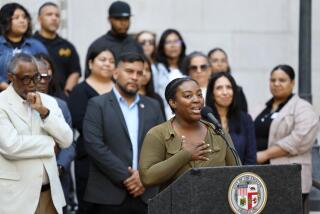Time to Examine Inadequate Jobless Benefits Programs
- Share via
President Reagan’s certain veto of a trade bill that was passed last week with a weak but better-than-nothing plant closure provision could have one redeeming feature: It just might call the nation’s attention to the appallingly inadequate assistance provided to millions of job-hungry Americans. That, in turn, could stimulate pressure for much-needed improvements.
The plant closing provision had overwhelming congressional support but, unfortunately, the margin would not be quite enough to override a Reagan veto.
Even if it does become law, it would do no more than require employers to demonstrate a modicum of decency and give workers, and their communities, a 60-day advance warning of plant closings and mass layoffs.
That minimal gesture of compassion to those whose paychecks are about to die is too much for this Administration.
While the measure would have given workers some advance warning of an imminent economic blow, it doesn’t even attempt to deal with the much larger problems the luckless unemployed face after the plant closings and mass layoffs come.
Financial help for the jobless comes from the unemployment benefit system, a $16-billion-a-year operation that began in 1935 as part of the Social Security program. It started off well but is hardly a roaring success these days.
Because of increasingly tight rules imposed both by the states and the Reagan Administration, only about 60% of those out of work and looking for jobs are even considered eligible to draw unemployment benefits. And an astonishingly few--only 25%--actually receive benefits.
The benefits average a meager $135 a week, or about 35% of the average national weekly wage--far less than enough to keep most families living as they do when the paychecks are rolling in.
In relatively prosperous California, the average is just $118, or 28% of the average U.S. weekly wage.
After an exhaustive study, a blue-ribbon National Commission on Unemployment Insurance concluded in 1980 that benefits should be 50% of the average worker’s wage.
The plight of the unemployed doesn’t seem to stir much national sympathy, or action, but the Administration insists that it isn’t really callous.
The new secretary of labor, Ann McLaughlin, says the Administration is concerned about the jobless and the unemployment insurance system created to help them--despite all evidence to the contrary.
Ready to look at the long-festering problem, McLaughlin has started a series of seminars with business and labor groups to examine the ineffectual jobless benefit system.
For starters, the secretary should look closely at what already has been done to the unemployed since the Reagan Administration took office. In 1981, there were 32,000 people in employment service offices around the country to help the jobless find work. Today, there are 17,000.
Or she might study the impact of the Reagan Administration’s drastic cuts in the number of people who process the claims of jobless workers. In 1981, 54,000 workers processed these claims. Today, there are just 40,000.
Congress will hold hearings this week to consider appropriations needed to run the system. It will be interesting to see if Reagan’s people ask for more money for staff to help workers get benefit checks and jobs.
The Administration points proudly to the fact that it is already experimenting with ideas to help the unemployed get jobs faster and so draw less in jobless benefits.
The experiments are based on the unlikely notion that many workers who lose their jobs really are not eager to find new ones and prefer to survive for up to 26 weeks with the average $135 weekly income benefit.
With this premise in mind, the Labor Department has launched a series of demonstration projects in six states to try to prod a few thousand of the presumably unambitious jobless to make a more diligent, faster search for jobs.
Workers chosen for the tests are offered a cash “bonus” if they can find a job quickly, within a specified period of time, and stop drawing unemployment benefits.
In addition, some are offered extra assistance in their hunt for jobs, and a few can get relocation allowances if they move to another community.
To find out what will most effectively entice jobless workers to intensify their job searches, both the size of the bonuses and the time workers have to find a job and win the money are varied from area to area.
Cash bonuses range from a low of $120 to as high as $1,200, and the time allowed to get a job ranges from six to 12 weeks.
The experts will try to determine, for example, whether a $120 cash bonus is as effective as a $1,200 bonus to get workers into a more enthusiastic job hunting mood.
Also, the experts may be able to estimate the most effective amount of time to allow workers to find jobs and get the bonuses.
A pilot project in New Jersey was deemed a success last week by McLaughlin. Some workers there got cash bonuses for finding full-time permanent work within 12 weeks.
Also, some received extra job assistance, job training and relocation allowances to help them get off the unemployment rolls.
Duration of unemployment for the 6,000 workers who took part in the test was cut by an average of nearly 10% and jobless benefits were reduced by $100 per worker, McLaughlin said, and that was encouraging. But a final report on the test is not due until next fall.
Congress will be asked to adopt the plan nationwide if the pilot projects show that the bonus system is cost effective.
That means the cash incentive bonuses have to cost less than the amount of money saved by paying less in unemployment benefits to workers, including those suspected of just not trying hard enough to find jobs.
While the Labor Department says preliminary results show the program is cost effective, the test runs are not conclusive.
In fact, the AFL-CIO’s unemployment insurance expert, Jim Ellenberger, says that in one supposedly cost-effective test, only 14% of those in the experiment actually received bonuses. The rest were unable to find jobs in the alloted time period and so got no bonuses.
But if all of those in the program had won bonuses, it would have cost $1.26 for each dollar saved in unemployment benefits, he said.
There is nothing wrong with the concept of experimenting with the bonuses. The trouble is that bonuses alone are unlikely to result in meaningful reductions in unemployment benefit payments.
The idea may not work on a large scale primarily because it is based on the faulty premise that large numbers of unemployed workers prefer low benefits instead of paychecks that on the average are nearly three times higher.
Far more valuable would be a federal plant closure provision to help workers brace for unemployment, along with increased jobless benefits to make unemployment more bearable, and more people to help the jobless find jobs and get their unemployment benefits.
And most important is making more jobs available. America needs a full employment policy that, among other things, would make government the employer of last resort when the private sector cannot absorb all who need jobs.
Conference Will Deal With Right Questions
They may not come up with all the answers, but participants in a conference on economic competition at UCLA on Friday certainly are being asked the right questions for a change.
Usually, conferences about America’s competitive position in the world focus on labor costs and productivity. Questions at the typical sessions might ask how productivity could be increased or whether the cost of American labor could be cut enough to meet the competition from Japan and other countries.
However, at the meeting being sponsored by the UCLA Institute of Industrial Relations, experts from government, industry, education and labor will go beyond such questions and consider ways that California can simultaneously be competitive and improve the economic and social conditions of its people.
One topic that should stir debate deals with the economic and social value of education.
UCLA education professor James S. Catterall will argue that California is likely to graduate “over-educated” students in the future.
Half of the job openings for the rest of this century will require no more than a high school diploma, but only about 35% of students will want to stop their education when they have those diplomas, he writes.
Catterall thinks that the students’ educational ambitions are excessive for their own and society’s needs.
Lewis C. Solmon, dean of UCLA’s graduate School of Education, gently ridicules the idea that we can be over-educated. He says that college education is intrinsically valuable and has a payoff greater than the potential income from a job. Also, college-educated students have the best chance of getting employment even if the jobs only require high school diplomas.
Solmon sounds wiser than Catterall, though the Friday debate may change that impression. They should offer other interesting ideas for combining increased economic competitiveness with increased well-being for those engaged in the competition.
More to Read
Get the L.A. Times Politics newsletter
Deeply reported insights into legislation, politics and policy from Sacramento, Washington and beyond. In your inbox twice per week.
You may occasionally receive promotional content from the Los Angeles Times.










